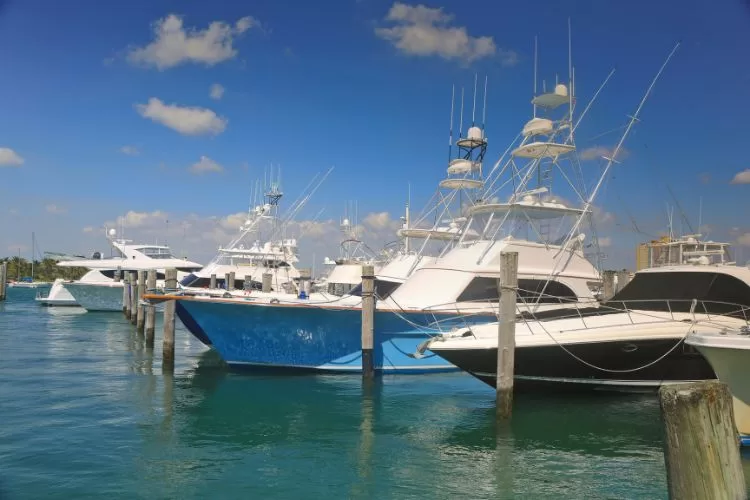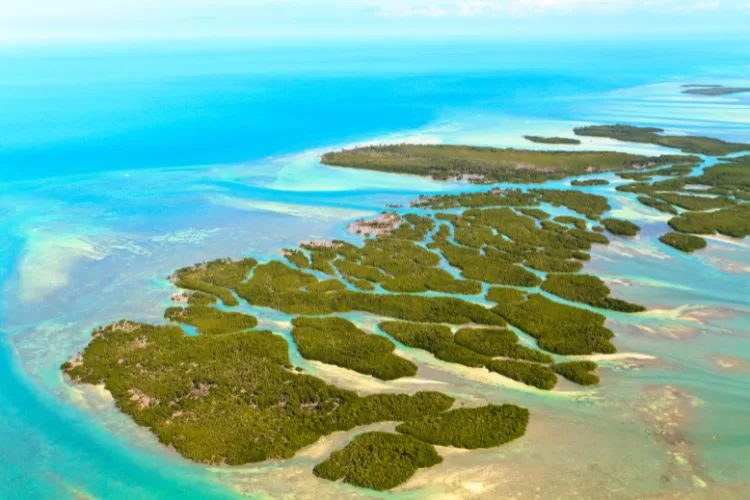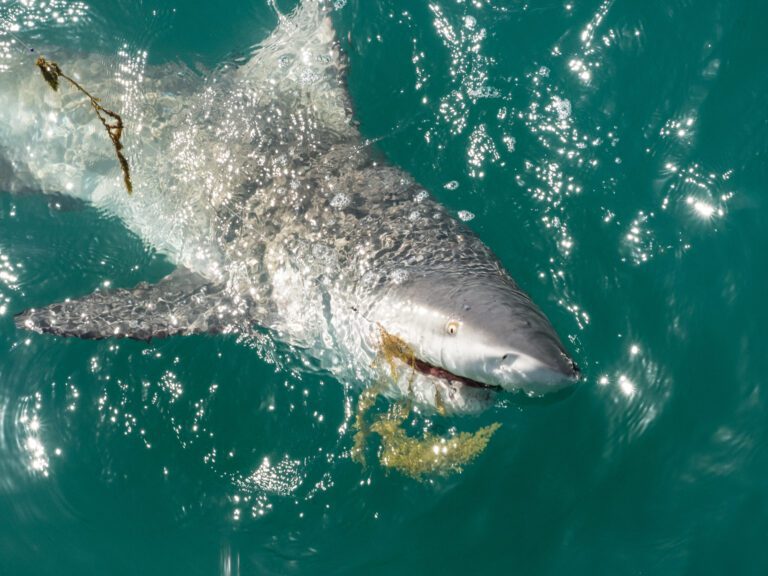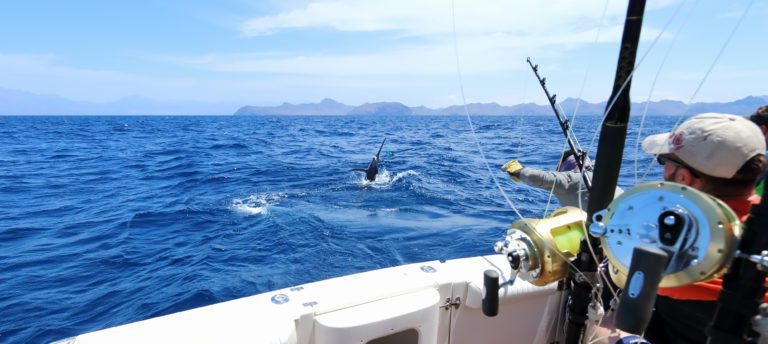Shark Fishing in Florida: Common Species, Best Places, & Pro Tips
Florida, The Sunshine State, appropriately nicknamed as such, has much more to offer than pristine golden beaches and luscious golf courses – it also has diverse shark fishing spots you need to check out!
Today, we’re taking you on a fun journey through Florida’s salty waters. In this guide you will learn key tips for catching sharks in Florida, learn the common shark species you’d find in Florida waters and what the best places to go shark fishing are.
Shark Fishing in Florida: Pro Tips & Tricks

Let’s share some wisdom with you, fellow shark fishing enthusiast. Check out our pro tips and tricks for an enjoyable fishing trip!
1. Know Your Shark Fishing Regulations
Get familiar with Florida’s shark fishing regulations because there are many!
Memorize specific rules relating to size limits, bag limits, and what species you can or can’t keep. Some species are also included on the State’s prohibited shark species list, like Hammerhead sharks, for instance.
So, best to stay in compliance with the law by doing your due diligence beforehand and as always make sure you also have a valid fishing license.
2. Gear Up!
Shark fishing may sound off-putting – but really, it’s all about the right tools. We recommend investing in sturdy gear suitable for shark fishing, such as heavy-duty rods and reels. A classic rod and reel combo is the PENN Senator 12/0 with an Ugly Stick 8′ 40-80#. Since this is a conventional reel, many anglers who are fishing from shore bring a kayak with them to drop the bait deep offshore as casting any length is not possible.
A strong fishing line (around 50-100 lbs test or more), along with circle hooks (5/0 size for smaller sharks and 8/0+ for the bigger species) will go a long way, too. Finally, throw in some steel leaders to help prevent bite-offs.
3. All About That Bait
One thing to remember: Sharks are opportunistic feeders. So the bait you go for has to be both delicious and ideal.
Best shark bait, in our opinion? Fresh chunks of mackerel, squid, barracuda, bonito, or ladyfish. Read more about the best shark baits and how to rig them here.
4. Timing
Sharks are most active at night. To maximize your chances of catching a shark you should be planning to start your fishing trip at dusk.
This is also advantagous to anglers fishing from shore as you are less likely to have to worry about any swimmers during that time.
5. Stay Safe
Yes, shark fishing is an exhilarating activity, but it won’t be if you’re not careful. You’re handling sharks, after all!
And even if the species you’re hunting is said to be friendly and not as aggressive as others, there will always be a chance they’d attack if provoked.
The mnemonic we find useful is ‘CAR’:
- Cover the shark’s eyes (once out of the water) to avoid stressing it out further
- Avoid holding the shark from its gills or tail
- Reduce fight time with the shark (i.e. don’t be a hero)
Make sure to also read this handy booklet from fellow Australian shark fishing anglers. They prepare you for both catching and releasing sharks and handling them safely.
Shark Fishing in Florida: 7 Common Shark Species
Florida is home to over 15 different shark species, which equates to around 3,000 sharks swarming around those saltwaters.
Below we only cover the most common ones that you’re sure to find on your next fishing trip:
1. Blacktip Shark
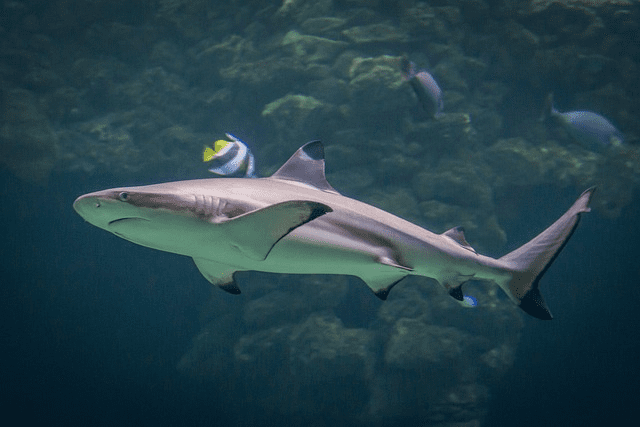
Blacktip sharks are a personal favorite of ours. They have sleek, black-tipped fins—especially on the dorsal and caudal sides (hence the name for ‘Blacktip’ sharks).
Blacktip sharks are generally mid-sized sharks, adults typically range from 5 to 6 feet. Anglers can find them in warm, coastal waters, such as the Atlantic Ocean or Gulf of Mexico.
The reason we love these sharks? They’re highly energetic swimmers that swim near the surface. Makes it easier to catch them! Blacktip sharks are known for their signature jumps when hooked!
Other Blacktip shark facts to know:
- (Relatively) Not Aggressive: Blacktips are curious creatures and are low-risk to humans.
- Near Threatened: Most sharks are endangered from overfishing, but Blacktips are currently listed as ‘Near Threatened’ by the IUCN.
2. Spinner Shark

Spinner sharks are named after the mesmerizing spinning behavior they often display. Our research uncovered that they do this for multiple purposes. It could be to disorient their prey or shake off parasites.
Either way, it’s quite a spectacular sight! And if you haven’t been lucky enough to see it, check it out here.
As for where you could spot them, Spinners prefer offshore waters and open sea rather than nearshores. They perform long-distance migrations so you’ll have to work hard to get them.
More interestingly, Spinners also:
- Can reach over 10 feet in size
- Are listed as ‘Near Threatened’ by the IUCN
- Are relatively harmless to humans compared to other shark species
3. Bull Shark

The name Bull sharks sounds scary, and it should! This species is named after both their appearance and their behavior.
For starters, Bulls have a stout and muscular body with a blunt snout. And perhaps a more notable feature is their impressive size – with big Bull sharks almost reaching 12 feet. They’re also known for their remarkable ability to tolerate both saltwater and freshwater, and having the highest testoterone levels in the animal kingdom.
That means you could find them anywhere! They thrive in a range of environments, whether shallow coastal waters or brackish estuaries.
Keep in mind, though, that Bulls are also:
- Aggressive Bull sharks: Bulls have a violent nature towards all species, including humans.
- Near Threatened: The IUCN has deemed Bulls as ‘Near Threatened’ due to overfishing.
4. Hammerhead Shark
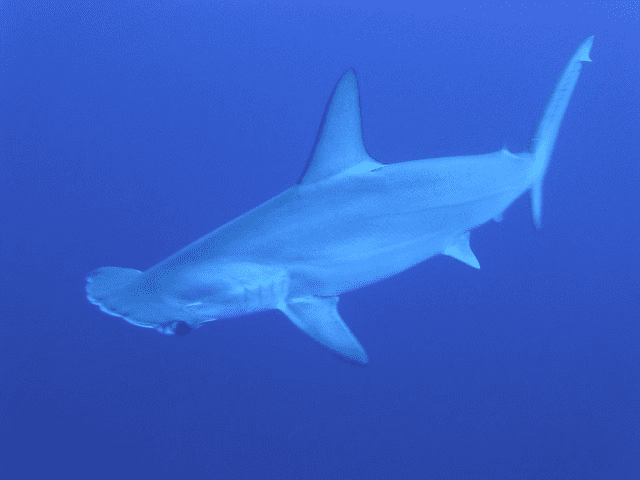
Hammerheads are a well-known shark species, made popular by beloved Disney movies, such as Finding Nemo, and Dreamwork classics, like Shark Tale.
Their flattened, T-shaped head is the most noticeable thing about their appearance. It grants them an enhanced sense of perception. It also means that certain hammerhead species reach impressive sizes, up to 20 feet!
Smaller sizes, on the other hand, are generally considered friendly – with few human attacks recorded. That said, you can find them in coastal areas, open oceans, or near islands.
Further info about Hammerheads include:
- Endangered/Near Threatened: The species are facing conservation concerns by the IUCN.
- Love Cool Water: Hammerheads don’t particularly enjoy warm waters and migrate often to cooler water bodies.
5. Tiger Shark

Another appropriately named shark is the Tiger shark. They exhibit dark, vertical stripes along their body that closely resemble tiger-like patterns. They also have a robust and heavily built frame similar to that of the big striped cat.
That grand size owes to them being among the larger shark species. Just to give you an idea: an adult can grow up to a massive 14-16 feet.
Similar to cats as well, Tiger sharks have excellent tracking skills, a keen sense of smell, and impressive vision. They’re nocturnal predators too, and the previous characteristics make them natural at catching prey.
Aside from that, the Tiger shark also:
- Is ‘Near Threatened’ according to the IUCN.
- Adapts to a variety of environments—coastal water, coral reefs, open oceans…etc.
- Is often called the ‘garbage can of the sea’ due to its versatile diet.
6. Nurse Shark

The Nurse shark species is perhaps the most unique kind there is among aquatic vertebrae to date. Did you know that they’re considered suction feeders as well?
Nurse sharks have a large pharynx and a small mouth. This enables them to suck food from bottom-dwelling waters—similar to a strong vacuum cleaner. Watch how here!
Near their mouth, you’ll also find two whisker-like sensory organs. Those two long barbels are highly distinctive of this species. Like the Tiger shark, they’re nocturnal predators, too.
Here’s what else you need to know about Nurse sharks:
- Habitat: Found in coral reefs, sandy bottoms, and rocky areas.
- Size: Can range between 7 to 9 feet – reaching 14 feet in some cases.
- Conservation status: Critically endangered due to overfishing.
7. Shortfin Mako Sharks

Mako sharks are one of premier game species of shark for anglers in Florida. Mako sharks are known for their distinct blue color and there vicious speed, capable of reaching speeds up to 45 miles per hour. They are the fastest shark in the ocean and their main prey of choice is tuna, but they also feed on squid, swordfish and other sharks.
Makos have impressive leaping ability, often breaching the surface in pursuit of prey or when hooked.
Their populations face threats from overfishing and bycatch, which raises concerns about the conservation of these magnificent creatures.
Here’s what else you need to know about Mako sharks:
- Mako can get very large up to 12 feet long and 1200 pounds!
- The IUCN has deemed Makos as ‘Endangered’ due to overfishing.
Some of other species of shark in Florida waters include: Lemon shark, Bigeye sand tiger sharks,
8 Best Places to Go Shark Fishing in Florida
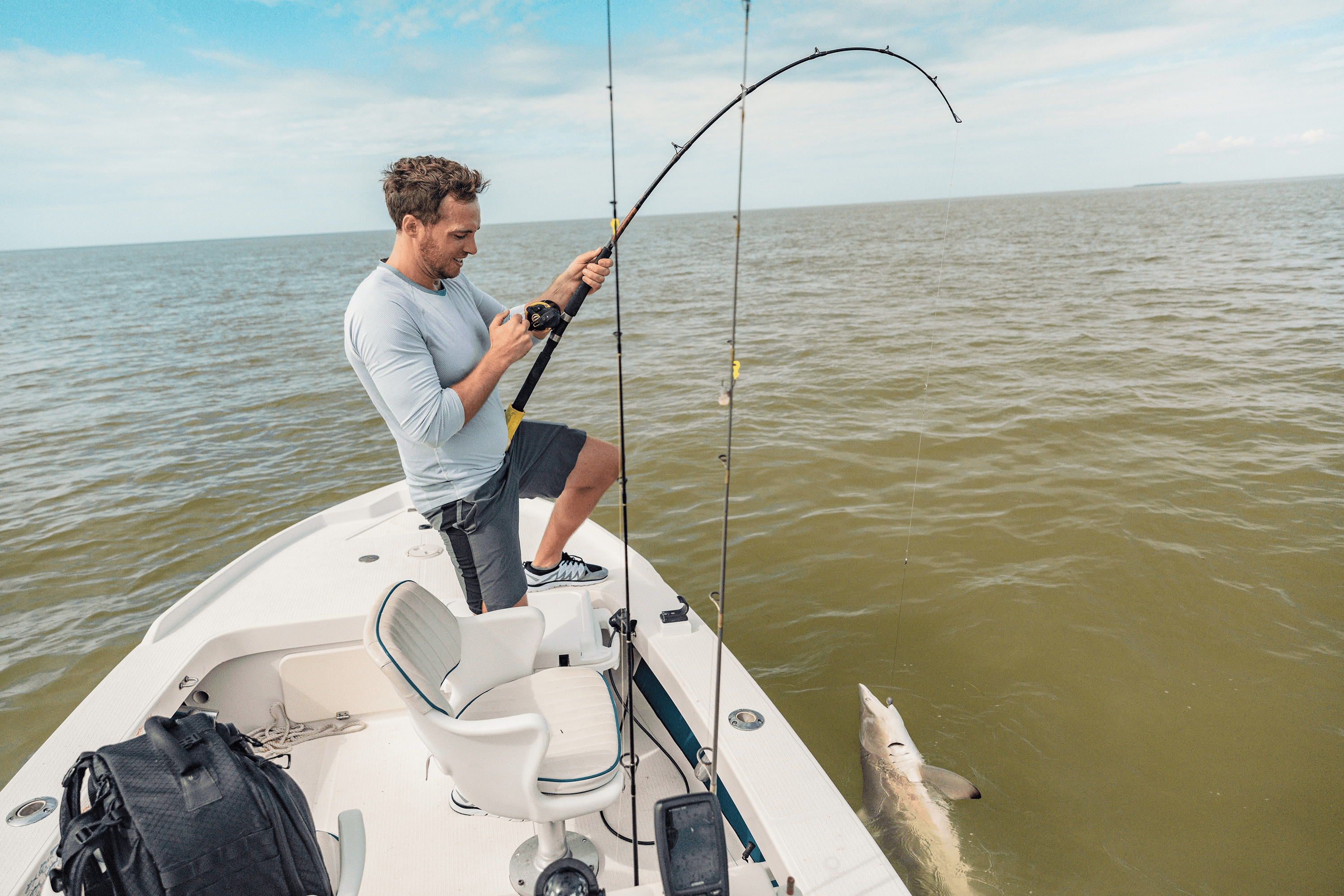
By now, you’re likely aching to go shark fishing right away. Considering the array of species we just covered, it makes sense! So, here are 8 of the best places to go shark fishing in Florida:
Cape Canaveral
Starting off, we have Cape Canaveral. Famous not only for its association with space exploration, but also for being a fantastic shark fishing spot. The Cape is situated on the Atlantic Coast, which gives anglers access to a diverse marine environment.
Plus, the coastal waters of Cape Canaveral are part of the migration routes of various shark species, including our beloved Blacktips and Hammerheads. The area is teeming with baitfish as well, which attracts many feeding sharks.
- Ideal time to go shark fishing: Sharks are available year-round and are most active during the early morning and late afternoon hours.
- Best beach for shark fishing: Cocoa Beach, Port Canaveral
Fort Myers
Walk along the Gulf of Mexico, located on the southwest coast of Florida, and you’ll stumble across Fort Myers – this warm, nutrient-rich, and diverse marine ecosystem makes it an excellent location for shark anglers.
Fort Myers is also home to various shark species, such as Blacktips, Bull sharks, Lemon sharks, and Hammerheads. Make sure to check out the fishing events and tournaments that Fort Myers hosts throughout the year too!
- Ideal time to go shark fishing: Go in the winter if you’re hunting for Bull sharks. Tigers, Nurses, Hammerheads, and other big species show up in the spring and summer.
- Best charter for shark fishing: Check out the Sanibel and Captiva Islands as well as the MacAttack Charters.
Destin
Ever been to the Emerald Coast? How about the beautiful Florida Panhandle area? Trust us when we say you’re in for a treat! From the pristine sandy beaches to the lucrative marine life, shark fishing enthusiasts swear by this place.
For starters, Destin provides access to Choctawhatchee Bay, where you can catch sharks close enough to the surface – among them are Bull sharks, great Hammerheads, and Tigers. The charters there are also family-friendly, so bring your kids along for some game!
- Ideal time to go shark fishing: May to August
- Best charter for shark fishing: Lock N Load Charter and Backcountry Outfitters
Daytona
For those seeking thrilling shark encounters, head down to Daytona Beach located on Florida’s Atlantic Coast. There, you have direct access to vast marine ecosystems where you’ll find all the common shark species we covered before.
Blacktips, Spinners, Hammerheads – you name it, it’s there! The water temperatures at Daytona are just right, and it’s also home to several fishing piers and jetties. No need to venture far; the water is shallow and deep enough for sharks to come to you.
- Ideal time to go shark fishing: Sharks are available year-round, but the best time is January to May
- Best charter for shark fishing: On the Hook and Pole Dancer
Jacksonville
Located on Florida’s northeast coast, along the St. Johns River, Jacksonville has a rich and beautiful marine life. Anyone visiting here has a range of fishing opportunities due to the nutrient-rich, freshwater and estuarine environments.
With such prime conditions, expect to encounter Blacktips, Lemon sharks, Bull sharks, and Spinners. Additionally, the area experiences seasonal shark migrations and is also family-friendly.
- Ideal time to go shark fishing: The fall, during dawn, dusk, or after dark.
- Best charter for shark fishing: Regardless Fishing Charters
Florida Keys
Now here’s a coral cay archipelago for ya! Florida Keys stands out as a tropical haven for shark fishing anglers. Due to it being the third-largest coral barrier reef system in the world, its turquoise waters easily support an abundance of shark species.
Powerful Hammerheads and sleek Blacktips? Check! Spinners and Nurse sharks? Check! Since the area is close to the Gulf Stream, the water is a little warm and is full of baitfish, too. In more sheltered areas of the Keys, you’ll find smaller Lemon and Blacktip sharks.
- Ideal time to go shark fishing: Go all year round, with March through September being the optimal time.
- Best charter for shark fishing: KeyZ Charters and Dream Chaser Charter
Tampa Bay
Tampa Bay is a vast estuarine system, connecting to the Gulf of Mexico. The mix of brackish and saltwater makes it a dynamic marine environment for sharks. Go fishing at the bay or any of the nearby coastal areas.
Anglers at Tampa Bay can enjoy both nearshore and inshore shark fishing opportunities. Make sure to hit the Bay’s channels, flats, and nearshore waters to land Blacktips, Bull sharks, Nurse sharks, and Lemon sharks.
- Ideal time to go shark fishing: Year-round available shark fishing – July, August, and September are ideal times, though.
- Best charter for shark fishing: Tampa Fishing Charters
Biscayne Bay
Another bay? Sorry, but we had to include Biscayne Bay on our list! The place is surrounded by the stunning landscapes of Miami. Its beauty and shallow waters offer favorable conditions for shark fishing.
The diverse ecosystem there includes seagrass beds, mangrove forests, and shallow flats. There are ample food sources there for Blacktips, Nurse sharks, and Lemon sharks, too.
- Ideal time to go shark fishing: Sharks are available year-round.
- Best charter for shark fishing: L&H Sportfishing and Salty Habitz
Shark Fishing in Florida: Summary
With that, we can confidently say we’ve covered everything you need to know about shark fishing in Florida. It’s a more lucrative pastime than you’d think – and the Sunshine State has many charters available for the anglers out there looking for an intoxicating thrill!
So, what are you waiting for? Start planning your next shark fishing trip with any one of the places we covered today. Make sure to let us know what kind of shark you managed to land and how big a game it was!
FAQs
How much does it cost to go shark fishing in Florida?
Depends. If you’re planning to fish with a guided charter, expect to pay from $150 to $500 per person. That number varies according to the duration of the trip, the type of boat, and whether other services are offered.
Opting for the independent route? Your expenses will range from $100 to $500 based on fishing gear used, size of bait, costs of acquiring a license…etc.
How many sharks can I catch in Florida?
The daily bag limit in Florida is one shark per person and two per fishing vessel—even if said vessel has more than two people onboard.


